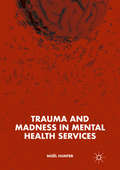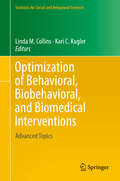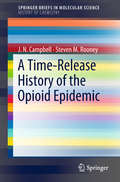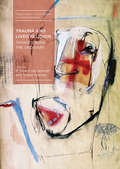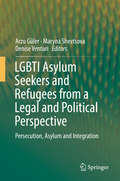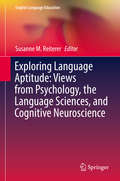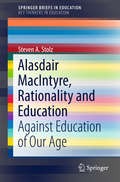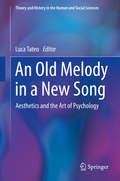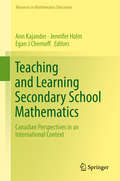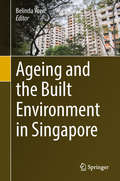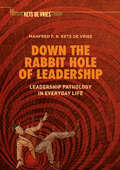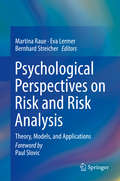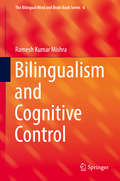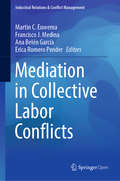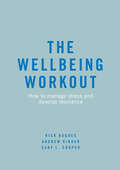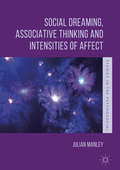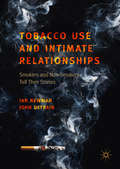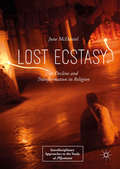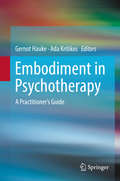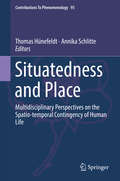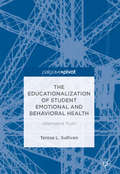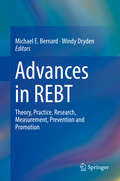- Table View
- List View
Trauma and Madness in Mental Health Services
by Noël HunterHow do survivors of child abuse, bullying, chronic oppression and discrimination, and other developmental traumas adapt to such unimaginable situations? It is taken for granted that experiences such as hearing voices, altered states of consciousness, dissociative states, lack of trust, and intense emotions are inherently problematic. But what does the evidence actually show? And how much do we still need to learn?
Optimization of Behavioral, Biobehavioral, and Biomedical Interventions: Advanced Topics (Statistics for Social and Behavioral Sciences)
by Linda M. Collins Kari C. KuglerBehavioral, biobehavioral, and biomedical interventions are programs with the objective of improving and maintaining human health and well-being, broadly defined, in individuals, families, schools, organizations, or communities. These interventions may be aimed at, for example, preventing or treating disease, promoting physical and mental health, preventing violence, or improving academic achievement. This book provides additional information on a principled empirical framework for developing interventions that are more effective, efficient, economical, and scalable. This framework is introduced in the monograph, "Optimization of Behavioral, Biobehavioral, and Biomedical Interventions: The Multiphase Optimization Strategy (MOST)" by Linda M. Collins (Springer, 2018). The present book is focused on advanced topics related to MOST. The chapters, all written by experts, are devoted to topics ranging from experimental design and data analysis to development of a conceptual model and implementation of a complex experiment in the field. Intervention scientists who are preparing to apply MOST will find this book an important reference and guide for their research. Fields to which this work pertains include public health (medicine, nursing, health economics, implementation sciences), behavioral sciences (psychology, criminal justice), statistics, and education.
A Time-Release History of the Opioid Epidemic (SpringerBriefs in Molecular Science)
by Steven M. Rooney J. N. CampbellThis Brief takes the reader on a chemical journey by following the history for over two centuries of how an opiate became an opioid, thus spawning an empire and a series of crises. These imperfect resemblances of alkaloids are both natural and synthetic substances that, particularly in America, are continually part of a growing concern about overuse. This seemed an inviting prospect for those in pain, but as the ubiquitous media coverage continues to lay bare, the levels of abuse point to the fact that perhaps an epidemic is upon us, if not a culture war. Seeking answers to how and why this addiction crisis transpired over two hundred years of long development, this Brief examines the role that the chemistry laboratory played in turning patients into consumers. By utilizing a host of diverse sources, this Brief seeks to trace the design and the production of opioids and their antecedents over the past two centuries. From the isolation and development of the first alkaloids with morphine that relieved pain within the home and on the battlefield, to the widespread use of nostrums and the addiction crisis that ensued, to the dissemination of drugs by what became known as Big Pharma after the World Wars; and finally, to competition from home-made pharmaceuticals, the progenitor was always, in some form, a type of chemistry lab. At times, the laboratory pressed science to think deeply about society's maladies, such as curing disease and alleviating pain, in order to look for new opportunities in the name of progress. Despite the best intentions opioids have created a paradox of pain as they were manipulated by creating relief with synthetic precision and influencing a dystopian vision. Thus, influence came in many forms, from governments, from the medical community, and from the entrepreneurial aspirations of the general populace. For better, but mostly for worse, all played a role in changing forever the trajectory of what started with the isolation of a compound in Germany. Combining chemistry and history in a rousing new long-form narrative that even broadens the definition of a laboratory, the origins and future of this complicated topic are carefully examined.
Trauma and Lived Religion: Transcending the Ordinary (Palgrave Studies in Lived Religion and Societal Challenges)
by R. Ruard Ganzevoort Srdjan SremacThis book focuses on the power of the ‘ordinary’, ‘everydayness’ and ‘embodiment’ as keys to exploring the intersection of trauma and the everyday reality of religion. It critically investigates traumatic experiences from a perspective of lived religion, and therefore, examines how trauma is articulated and lived in the foreground of people’s concrete, material actualities. Trauma and Lived Religion seeks to demonstrate the vital relevance between the concept of lived religion and the study of trauma, and the reciprocal relationship between the two. A central question in this volume therefore focuses on the key dimensions of body, language, memory, testimony, and ritual. It will be of interest to academics in the fields of sociology, psychology, and religious studies with a focus on lived religion and trauma studies, across various religions and cultural contexts.
LGBTI Asylum Seekers and Refugees from a Legal and Political Perspective: Persecution, Asylum and Integration
by Arzu Güler Maryna Shevtsova Denise VenturiThis book addresses the ‘three moments’ in lesbian, gay, bisexual, transgender and intersex (LGBTI) asylum seekers’ and refugees’ efforts to secure protection: The reasons for their flight, the Refugee Status Determination process, and their integration into the host community once they are recognized refugee status.The first part discusses one of the most under-researched areas within the literature devoted to asylum claims based on sexual orientation and gender identity, namely the reasons behind LGBTI persons’ flight. It investigates the motives that drive LGBTI persons to leave their countries of origin and seek sanctuary elsewhere, the actors of persecution, and the status quo of LGBTI rights. Accordingly, an intersectional approach is employed so as to offer a comprehensive picture of how a host of factors beyond sexual orientation/gender identity impact this crucial first stage of LGBTI asylum seekers’ journey.In turn, the second part explores the challenges that LGBTI asylum seekers face during the RSD process in countries of asylum. It first examines these countries’ interpretations and applications of the process in relation to the relevant UNHCR guidelines and questions the challenges including the dominance of Western conceptions and narratives of sexual identity in the asylum procedure, heterogeneous treatment concerning the definition of a particular social group, and the difficulties related to assessing one’s sexual orientation within the asylum procedure. It subsequently addresses the reasons for and potential solutions to these challenges.The last part of the book focuses on the integration of LGBTI refugees into the countries of asylum. It first seeks to identify and describe the protection gaps that LGBTI refugees are currently experiencing, before turning to the reasons and potential remedies for them.
Exploring Language Aptitude: Views from Psychology, the Language Sciences, and Cognitive Neuroscience (English Language Education #16)
by Susanne M. ReitererThis book presents original, empirical data from quantitative and qualitative research studies in the field of language learning aptitude, ability, and individual differences. It does so from the perspectives of Second Language Acquisition, psychology, neuroscience and sociolinguistics. All studies included in the book use a similar and uniform layout and methodology. Each chapter contains a study examining factors such as memory, personality, self-concept, bilingualism and multilingualism, education, musicality or gender. The chapters investigate the influence of these concepts on language learning aptitude and ability. Several of these chapters analyse hypotheses which have never been tested before and therefore provide novel research results. The book contributes to the field both by verifying and contesting existent findings and by exploring novel approaches to devising research in the subject area.
Handbook of Trait Narcissism: Key Advances, Research Methods, and Controversies
by Anthony D. Hermann Amy B. Brunell Joshua D. FosterThis unique reference surveys current theoretical and empirical advances in understanding individual differences in narcissistic personality, as well as the latest perspectives on controversies in the field. Wide-ranging expert coverage examines the many manifestations of narcissism, including grandiose, vulnerable, communal, and collective varieties. Narcissism’s etiology, the role of social media culture in its maintenance and amplification, and the complex phenomena of narcissistic leadership, spirituality, friendship, and love are just a snapshot of topics that are examined. The book’s section on intrapersonal processes delves into how the narcissistic mind works, as well as how narcissists feel about themselves and their peers. It also investigates narcissists’ grasp of emotions. Chapters explore associated personality traits and numerous other important correlates of narcissistic personality. New approaches to research, assessment methods, and opportunities for intervention—both immediate and long-term, are discussed throughout. In addition, trait narcissism is examined in an even-handed manner that incorporates state-of-the-art research into antecedents and consequences (both good and bad) of narcissistic personality.Among the topics in the Handbook:What separates narcissism from self-esteem? A social-cognitive perspective.The many measures of grandiose narcissism.Parents’ socialization of narcissism in children.What do narcissists know about themselves? Exploring the bright spots and blind spots of narcissists’ self-knowledge.Understanding and mitigating narcissists’ low empathy.Interpersonal functioning of narcissistic individuals and implications for treatment engagement. Offering nuanced analysis of a particularly timely subject, The Handbook of Trait Narcissism is fascinating and informative reading for psychologists and psychology students, as well as scholars in anthropology, sociology, economics, political scientists, and more.
Alasdair MacIntyre, Rationality and Education: Against Education of Our Age (SpringerBriefs in Education)
by Steven A. StolzDespite Alasdair MacIntyre being known as an academic who has made many notable contributions to a range of areas in philosophy, his thinking on education is not as well-known and/or properly understood by most audiences and readerships that predominantly reside in educational contexts. With this in mind, this book aims to provide a critique of MacIntyre’s thinking about education, and hence commences with a central theme found in MacIntyre’s extensive corpus concerning the fragmentation and disunification of ideas found in our culture and society that stems both from the rejection of metaphysics and what it means to be a human being living within the context of history. According to MacIntyre, part of the problem why this has occurred is due to educational institutions, particularly universities failing to resist the pressure exerted from industry and the state to conform. Unfortunately, this has resulted in a type of intellectual dissensus where the shared conceptions of rational enquiry and the role of reason have been replaced by pluralistic notions of private and personal choices concerning the good, and a disillusionment with reason that is ultimately exhibited as apathy and conformism. In order to overcome this apathy and conformism found in our culture and society, MacIntyre’s educational project is concerned with the cultivation of rationality; however, this is not an easy undertaking because it involves students being confronted with alternative – sometimes rather hostile – rival traditions so they both come to see rival points of view and understand that each tradition, including their own, does not come from a neutral or value-neutral standpoint. To MacIntyre, dialectical encounters between traditions is a crucial starting point of a good education, but for intellectual and academic progress to be made, rational enquiry needs to be grounded in a shared understanding of first principles that aims at truth and rational vindication. It is this shift in thinking that is of interest in the latter part of this book, particularly MacIntyre’s views around tradition-orientated communities of practice. Here, MacIntyre is concerned with the praxis of his educational project and the crucial role tradition-orientated communities play in the cultivation of independent reasoners who are capable of seeing the interconnectedness between different forms of knowledge that can lead us to an informed discovery of both the truth, and of the good, but most importantly exhibit virtuous dispositions which are vital to good practical reasoning.
An Old Melody in a New Song: Aesthetics and the Art of Psychology (Theory and History in the Human and Social Sciences)
by Luca TateoThis book explores the relationship between cultural psychology and aesthetics, by integrating the historical, theoretical and phenomenological perspectives. It offers a comprehensive discussion of the history of aesthetics and psychology from an international perspective, with contributions by leading researchers from Serbia, Austria, Portugal, Norway, Denmark, and Brazil. The first section of the book aims at summarizing the debate of where the song comes from. It discusses undeveloped topics, methodological hints, and epistemological questions in the different areas of contemporary psychological sciences. The second section of the book presents concrete examples of case-studies and methodological issues (the new melodies in psychological research) to stimulate further explorations. The book aims to bring art back into psychology, to provide an understanding for the art of psychology. An Old Melody in a New Song will be of interest to advanced students and researchers in the fields of educational and developmental psychology, cultural psychology, history of ideas, aesthetics, and art-based research.
Teaching and Learning Secondary School Mathematics: Canadian Perspectives in an International Context (Advances in Mathematics Education)
by Jennifer Holm Ann Kajander Egan J ChernoffThis volume brings together recent research and commentary in secondary school mathematics from a breadth of contemporary Canadian and International researchers and educators. It is both representative of mathematics education generally, as well as unique to the particular geography and culture of Canada. The chapters address topics of broad applicability such as technology in learning mathematics, recent interest in social justice contexts in the learning of mathematics, as well as Indigenous education. The voices of classroom practitioners, the group ultimately responsible for implementing this new vision of mathematics teaching and learning, are not forgotten. Each section includes a chapter written by a classroom teacher, making this volume unique in its approach. We have much to learn from one another, and this volume takes the stance that the development of a united vision, supported by both research and professional dialog, provides the first step.
Ageing and the Built Environment in Singapore
by Belinda YuenThis book contains a collection of studies that have been conducted among older residents in Singapore. Different methods, from surveys to crowd sourcing, have been used to investigate the older adults’ lived experiences and social participation in the residential environment. The findings reveal that older residents interact with the built environment in ways that reflect their changing capabilities and lifestyles. Since the built environment – where we live and go – can have an important impact on our daily lives, especially among older people, understanding these experiences and perceived needs is important to help older individuals age within their community.
Down the Rabbit Hole of Leadership: Leadership Pathology in Everyday Life
by Manfred F. Kets de VriesIn the previous book in this series, Manfred Kets de Vries observed the experiences of leaders on a rollercoaster ride through their professional and personal lives. Now, he follows them down the rabbit hole into the unknown, where, like Lewis Carroll’s Alice, they find a dystopian Wonderland in which everyone seems to have gone mad and life functions according to its own crazy logic, throwing up all kinds of obstacles in the search for truth.Understanding what is happening around us has become more difficult than ever in the Age of Trump. Don’t imperatives like “build that wall” sound very much like “Off with his head”? Unfortunately, and unlike Alice, we are not going to wake up from a bad dream and discover that everything is “nothing but a pack of cards”.The first part of this book looks at the psychodynamics of leadership in both a business and a political context. The second focuses on the psychopathology of everyday life in organizations and the seemingly endless ways people can make a mess of things – including mega pay packages, acting out, digital addiction and other dysfunctional behaviour patterns. Each chapter ends with a brief anecdote to illustrate the dilemma it presents.In short, sharp nuggets, Kets de Vries helps make sense of how the madness of the present has affected leadership in organizations and the workplace.
Psychological Perspectives on Risk and Risk Analysis: Theory, Models, and Applications
by Martina Raue Eva Lermer Bernhard StreicherThis authoritative collection goes beyond economic statistics and probability data to offer a robust psychological understanding of risk perception and risk taking behavior. Expert contributors examine various risk domains in life, and pinpoint cognitive, emotional, and personality factors contributing to individual differences in risk taking as well as the many nuances social demographics (e.g., culture, gender) bring to risk decisions. Coverage takes competing theories and studies into account to identify mechanisms involved in processing and acting on uncertainty. And implications and applications are demonstrated in varied fields, from updated risk models for the insurance sector to improved risk communication in health services to considering risk perception in policy decisions. A sampling of the topics: Personality and risk: beyond daredevils—risk taking from a temperament perspective.Cognitive, developmental, and neurobiological aspects of risk judgments.The group effect: social influences on risk identification, analysis, and decision-making.Cognitive architectures as a scaffolding for risky choice models.Improving understanding of health-relevant numerical information.Risk culture as a framework for improving competence in risk management. Psychological Perspectives on Risk and Risk Analysis will be of great interest to researchers in and outside of psychology, including decision-making experts and behavioral economists. Additionally, this volume will appeal to practitioners who often have to make risky decisions, such as managers and physicians.
Bilingualism and Cognitive Control (The Bilingual Mind and Brain Book Series #6)
by Ramesh Kumar MishraThis thought-provoking monograph makes a multidisciplinary case for bilingualism as a possible enhancer of executive function, particularly cognitive control. Its central focus is the cognitive operations of the bilingual brain in processing two languages and whether they afford the brain a greater edge on neuroplasticity—in short, a cognitive advantage. Major issues and controversies in the debate are analyzed from cognitive neuroscience, psycholinguistic, and integrative perspectives, with attention paid to commonly and rarely studied domains at work in bilingual processing. The author also pinpoints future areas for improved research such as recognizing the diversity of bilingualism, not simply in languages spoken but also in social context, as seen among immigrants and refugees. Included in the coverage: The evolution of bilingualism.What goes on in a bilingual mind? The core cognitive mechanisms.Cognitive advantage of bilingualism and its criticisms.Neuroscience of bilingualism.Bilingualism, context, and control.Attention, vision, and control in bilinguals. With its cogent takes on ongoing questions and emerging issues, Bilingualism and Cognitive Control is of immediate interest to bilingual researchers and practitioners interested in understanding the behavioral aspects and neurobiology of bilingualism and the dynamic character of the bilingual/multilingual/second language learner’s mind, as well as the growing number of advanced undergraduate and graduate students interested in the psychology/psycholinguistics of bilingualism, bilingual cognitive psychology, cognitive science, and cognitive neuroscience.
Mediation in Collective Labor Conflicts (Industrial Relations & Conflict Management)
by Ana Belén García Martin C. Euwema Francisco J. Medina Erica Romero PenderThis open access book opens up the black box of mediation in collective conflicts through the analyses and comparisons of various systems. Mediation and related third party interventions such as conciliation and facilitation are discussed as effective prevention and regulation tools for different types of collective labor conflicts. These interventions fit in a new developed five-phase model of collective conflicts in organizations, going from capacity building in latent conflicts, through conciliation, mediation and arbitration in escalating phases, to rebuilding of trust after hot conflicts. The authors promote understanding and discussion with regards to labor mediation systems, presenting comparative research on the perspectives of mediators and users of mediation. This book describes and analyses laws, regulations and practices of mediation in seventeen countries, with a relative strong emphasis on Europe. Part 1 presents theoretical frameworks on conciliation and mediation in collective labor conflicts. Part 2 presents regulations and practices in 12 European countries: Belgium, Denmark, Estonia, France, Italy, Poland, Portugal, Spain, The Netherlands, and the United Kingdom. Part 3 discusses mediation in these collective conflicts in Australia, China, India, South Africa and the USA. Part 4 offers conclusions and ways forward. This book offers analyses, good practices and developments for third party intervention in collective labor conflicts in global and local changing environments. This book is a must-read for policy makers, , social partners at different levels, as well as scholars and practitioners in industrial relations, human resources management and conflict management, particularly conciliators and mediators.
The Wellbeing Workout: How to manage stress and develop resilience
by Cary L. Cooper Rick Hughes Andrew KinderIf you want to get physically fit you start working out. But if you want results, you can’t just do just any workout – you need one tailored to your own body’s needs and personal situation. It’s the same with wellbeing. What constitutes ‘stress’ to one person may be motivating, inspiring and focusing for another. Our capacity for resilience varies depending on individual circumstances and from situation to situation. What is consistent and universal is that we all struggle with stress and resilience, and we all need to be open to figuring out how best to effectively manage stress to create greater personal resilience that will itself help us to cope better. This book offers you an encyclopaedia of self-help options for you to adapt according to how you tick and to the circumstances you find yourself in at any given moment. It addresses 60 different issues, and for each one provides a short ‘Spotlight’ to understand the issue, ‘Top Tips’ for dealing with it, and an ‘Action Plan’ to put those tips into practice. Wellbeing is about managing the ebbs and flows of what life throws at us. It’s a mindset, a personal commitment and an ongoing endeavour. But if we adopt a focused and sustained engagement with this journey, then we’ll learn to embrace and reap the benefits of ‘being well’.
Social Dreaming, Associative Thinking and Intensities of Affect (Studies in the Psychosocial)
by Julian ManleyThis book describes a way of sharing dreams in a group, called ‘social dreaming’. It explores how the sharing of real, night time dreams, in a group, can offer information on and insight into ourselves and the worlds we live in and share. It investigates how we can turn dream images, and ideas and feelings that arise from these images, into conscious thought, before describing the ways in which these can be used. Using a background of the psychosocial combined with a philosophical lens influenced by the work of Gilles Deleuze, Julian Manley shows how social dreaming can be understood as a Deleuzian ‘rhizome of affects’, a web or a root design where things interconnect in a random and spontaneous fashion rather than in a sequential or linear way. He illustrates how social dreaming can link dreams together into a collage of images, and compares this to the rhizome, where clusters of emotional intensity – which emerge from the dream images – weave and interconnect with other clusters, forming a web of interlinked dream images and emotions. From the basis of this rhizome emerges an interpretation of social dreaming as a ‘body without organs’ and the social dreaming matrix as a ‘smooth space’ where meanings emerge from the way these images form connections, and come and go according to our emotions at any particular moment.
Tobacco Use and Intimate Relationships: Smokers And Non-smokers Tell Their Stories
by Ian Newman John DeFrainThis book presents a wide variety of insights into the effects of smoking on both smokers and non-smokers. Based on extensive questionnaire surveys from across the USA, this research explores the complex dynamics of intimate relationships and how they are affected by smoking, especially with regard to honest communication. The volume delves into the battles which take place behind closed doors as both smokers and non-smokers invoke personal rights and argue their positions. Finally, the authors explore how health policy and public policy can better serve both smokers and non-smokers, and what the future may hold for the regulation of tobacco use.
Lost Ecstasy: Its Decline and Transformation in Religion (Interdisciplinary Approaches to the Study of Mysticism)
by June McDanielThis book is a study of religious ecstasy, and the ways that it has been suppressed in both the academic study of religion, and in much of the modern practice of religion. It examines the meanings of the term, how ecstatic experience is understood in a range of religions, and why the importance of religious and mystical ecstasy has declined in the modern West. June McDaniel examines how the search for ecstatic experience has migrated into such areas as war, terrorism, transgression, sexuality, drug use, and anti-institutional forms of spirituality. She argues that the loss of religious and mystical ecstasy, as both a religious goal and as a topic of academic study, has had wide-ranging negative effects. She also proposes that the field of religious studies must go beyond criminalizing, trivializing and pathologizing ecstatic and mystical experiences. Both religious studies and theology need to take these states seriously as important aspects of lived human experience.
Embodiment in Psychotherapy: A Practitioner's Guide
by Gernot Hauke Ada KritikosThis groundbreaking clinical guide explores the theory behind embodiment in psychotherapy, the science that underlies its methods, and how this knowledge can offer greater depth to clinical practice. Experts across the cognitive and behavioral sciences analyze the complex roles of the body in helping create the self and convey agency, and the essential cognitive, emotional, and behavioral processes expressed in movement, gestures, and facial expressions. Diverse techniques are shown bridging gaps between emotional and bodily awareness and verbal and nonverbal communication to reinforce self-regulation, navigate social relationships, and support the therapeutic bond. These practical guidelines demonstrate the versatility of embodiment work in use with individuals, couples, and groups in addressing a wide range of emotional, interpersonal, and somatic concerns. Among the topics covered: · Embodiment as an organizing principle. · Generating body focus: the gate to embodied work and emotional awareness. · Embodiment of social interaction: our place in the world around us. · Resource activation: bringing values into the flesh. · Therapeutic alliance: grounding interaction in space. · The power of embodying values in work place teams. Expanding on while strengthening traditional theory and methods, Embodiment in Psychotherapy brings new directions in healing to researchers, clinicians, and psychotherapists of all schools in psychiatry, counseling, coaching, and social work, as well as psychology students, trainers, managers, and supervisors.
Sex for Structuralists: The Non-Oedipal Logics of Femininity and Psychosis
by Shanna de la TorreThis book argues that structuralism makes itself useful when it engages with the non-Oedipal logics of femininity and psychosis. Building from the psychoanalytic belief that norms repress unconscious desire while structures open onto the creative resources of the symbolic, Sex for Structuralists looks to key texts in myth, trauma, and unconscious fantasy by Sigmund Freud, Jacques Lacan, and Claude Lévi-Strauss. It also examines innovative writings by contemporary Lacanian thinkers in order to discover what becomes of structuralism when the ground upon which it ostensibly stands (namely, that of the zero symbol or the incest prohibition) drops out from under it.
Situatedness and Place: Multidisciplinary Perspectives on the Spatio-temporal Contingency of Human Life (Contributions To Phenomenology #95)
by Thomas Hünefeldt Annika SchlitteThis book explores the ways in which the spatio-temporal contingency of human life is being conceived in different fields of research. Specifically, it looks at the relationship between the situatedness of human life, the situation or place in which human life is supposed to be situated, and the dimensions of space and time in which both situation and place are usually themselves supposed to be situated. Over the last two or three decades, the spatio-temporal contingency of human life has become an important topic of research in a broad range of different disciplines including the social sciences, the cultural sciences, the cognitive sciences, and philosophy. However, this research topic is referred to in quite different ways: while some researchers refer to it in terms of “situation”, emphasizing the “situatedness” of human experience and action, others refer to it in terms of “place”, emphasizing the “power of place” and advocating a “topological” or “topographical turn” in the context of a larger “spatial turn”. Interdisciplinary exchange is so far hampered by the fact that the notions referred to and the relationships between them are usually not sufficiently questioned. This book addresses these issues by bringing together contributions on the spatio-temporal contingency of human life from different fields of research.
The Educationalization of Student Emotional and Behavioral Health: Alternative Truth
by Teresa L. SullivanThis book examines the current political, social, and economic positions that push the responsibility for the emotional health of students onto schools. The context of recent education reform asks schools to mitigate adverse emotional health of students by developing and implementing broad programming, curriculum, and policies immersed in cognitive behavioral approaches. The design plan is intended to build resilience and develop strategies in students that will enable them to succeed despite adverse structural conditions. The swindle of education reform is that it deflects and blames families, youth, and the school system for the social ills of society. From the perspective of a thirty year Massachusetts educator and high school principal emerges an alternative reality that not only challenges decades of education reform entrenched in victim blaming but also exposes a serious responsibility gap.
Therapy as Discourse: Practice and Research (The Language of Mental Health)
by Tom Strong Olga SmoliakThis book addresses the premise that therapy can be understood, practiced, and researched as a discursive activity. Using varied forms of discourse analysis, it examines the cultural, institutional, and face-to-face communications that shape, and occur within, therapies that are discursively understood and practiced. By first providing an overview of commonalities across discursive therapies and research approaches, the authors discursively examine general aspects of therapy. Topics explored include subjectivity, psychological terms, institutional influences, therapeutic relationships, therapists’ ways of talking and questioning, discursive ethics, and assessment of therapeutic processes and outcomes. This book offers a macro-analysis of the conversational practices of a discursively informed approach to therapy; as well as a micro-analysis of the ways in which language shapes and is used in a discursively informed approach to therapy. This book will interest practitioners seeking to better understand therapy as a discursive process, and discourse analysts wanting to understand therapy as discursive therapists might practice it.
Advances in REBT: Theory, Practice, Research, Measurement, Prevention and Promotion
by Michael E. Bernard Windy DrydenThis authoritative volume commemorates six decades of Rational Emotive Behavior Therapy by assembling its current state of theory, practice, and research. Bedrock chapters on defining features, assessment and measurement, and empirical findings place REBT squarely in the cognitive-behavioral landscape, reinforcing its status as a significant therapeutic approach. The book’s palette of applications shows the flexibility and effectiveness of REBT in school, workplace, and other settings, with worried parents and “stuck” athletes, and as a foundation for brief interventions. And the survey of guiding principles and the evolution of the method by REBT founder Albert Ellis is a testament to its enduring clinical value. Included in the coverage: · A comparison of REBT with other cognitive behavior therapies. · The measurement of irrationality and rationality. · Empirical Research in REBT theory and practice. · Rational Emotive Behavior Therapy and the working alliance. · Brief interventions in Rational Emotive Behavior Therapy. · REBT and positive psychology. · Rational emotive behavior education in schools. Advances in REBT will be welcomed as a definitive reference across the REBT community: frontline clinicians, novices, trainees, students, and researchers. Seasoned practitioners looking to incorporate REBT into their repertoires will find it immensely helpful.
